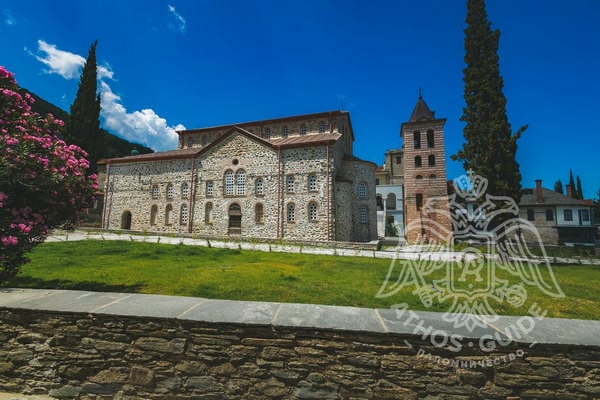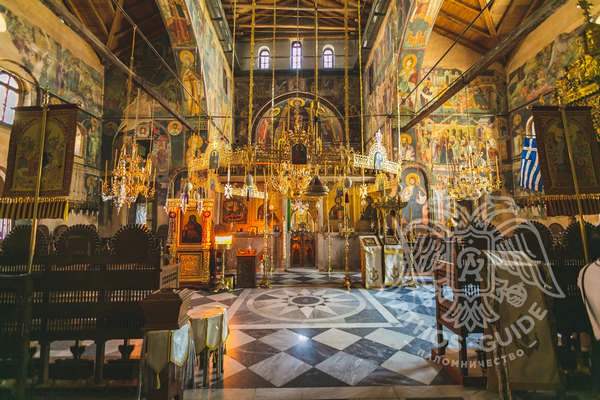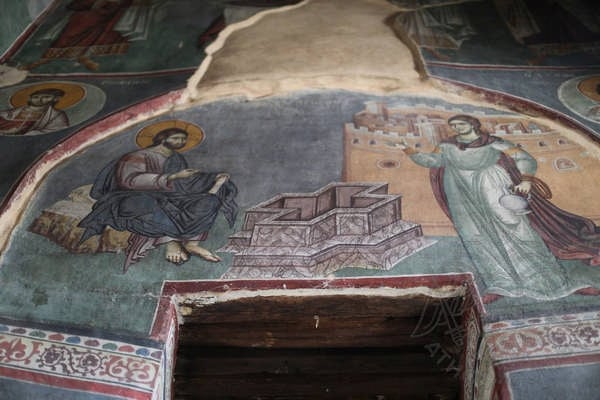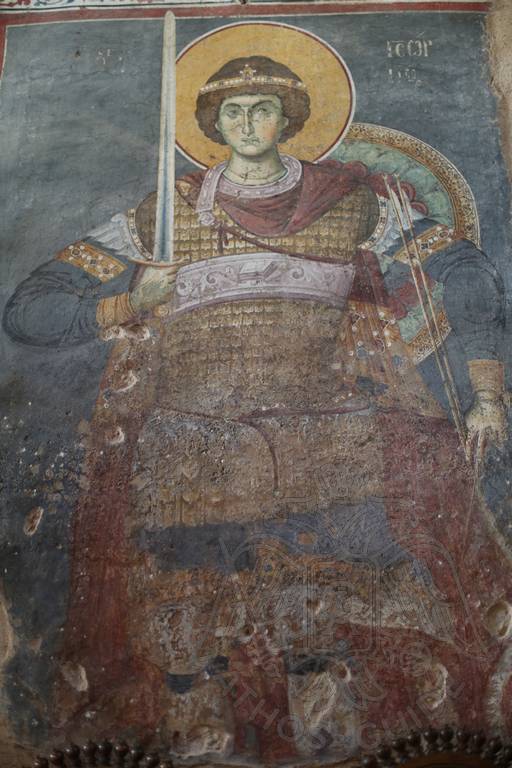
The temple of the Protaton, built according to the oldest type of basilica, has large surfaces which are suitable for the creation of extensive multi-faceted decorative compositions. Having this advantage, Manuel Panselinos was able to create original works of great art. Although special planning was required, as well as minor interventions in the building itself, nevertheless the fresco decoration of the Protaton has been a model of Byzantine iconographic art for all subsequent artists.
Most of the depictions of the church have survived. However, the destruction of the frescoes in the upper part, as well as the pediments of the central and transept naves, does not allow us to have a complete picture of the original form of the artist's iconographic programme. During the period of Ottoman rule, during the 16th-17th centuries, the pictorial decoration was supplemented by a few additional iconographic works. In the 1950s, extensive conservation and restoration work took place. The latest research revealed a later layer of paintings dating from the Middle Byzantine period.
Artistic Compositions
The artistic compositions of the temple of Protaton have a monumental character. Their width, their multifaceted representations, as well as their particular structure, contribute to a magnificent outcome.
Symmetry and balance are their main characteristics. The representations that complement the main theme are usually placed on either side of the central axis.
The strictness, symmetry and balance of the compositions interact with the internal rhythm of the works. The figures come to life without destroying the monumental character of the composition. Through the movements of their bodies, the individual figures are introduced into a kind of dialogue, framing the central figure which is organically integrated into the composition.
 The particular rhythmic movements wonderfully complement the sense of tranquillity of the paintings. They are soft and gentle. The rhythmic dialogue is one of the primary characteristics that distinguish the frescoes of the Protaton from any other monumental iconographic work of the same period.
The particular rhythmic movements wonderfully complement the sense of tranquillity of the paintings. They are soft and gentle. The rhythmic dialogue is one of the primary characteristics that distinguish the frescoes of the Protaton from any other monumental iconographic work of the same period.
The Iconographic Programme
The iconographic program of Panselinos includes horizontal zones, the lower ones of which are decorated with a number of plumes and floral motifs. In the central nave, the surface is divided into five zones. The fourth, which depicts the figures of the saints, is the widest (2,40 m).
The iconographic programme of the temple includes 40 central multi-figure compositions, divided into four thematic sections. The starting point of the programme is the twelve great feasts of the church, the cycle of the Passion of the Lord and His appearance after the Resurrection, some pictorial references to the Holy Trinity and scenes from the life of the Virgin Mary.
Individual figures of saints are placed in various parts of the church. There are representations of the prophets, apostles, hierarchs, military saints and martyrs. Among others, there are icons of ascetics and monks of Mount Athos. In the upper zone of the central nave, the saints of the Old Testament from Adam to Joseph are also depicted. The twelve apostles are represented in the third zone of the central nave and in the second zone of the transept.
Thus, in the temple of the Protaton we can follow the whole course and history of the Church, from the forefathers who preceded it, the prophets who foretold its foundation, the apostles who formed it, the martyrs who strengthened it and the bishops who adorned it.
.jpg) The Twelve Great Feasts of the Church
The Twelve Great Feasts of the Church
The cycle of the twelve great feasts of the church, with the Assumption of the Virgin Mary being the greatest of the representations, constitute a pictorial depiction of the most important events in the life of Jesus Christ. The sequence of the scenes follows the narrative of the Gospel. The depiction is directly linked to the Divine Liturgy and the sacrament that takes place inside the temple.
The iconographic programmes, as they were formed after iconoclasm, seek to highlight the historical and doctrinal character of the incarnation of the Lord.
As far as the twelve great feasts are concerned, in the temple of Protaton there are represented the following scenes:
- Τhe Annunciation
- Christmas
- Τhe Last Supper
- Τhe Baptism
- Τhe Transfiguration of the Saviour
- Τhe Resurrection of Lazarus
- Τhe Entry into Jerusalem
- Τhe Crucifixion
- Τhe Descent into Hades
- Τhe Resurrection
- Pentecost
- Τhe Assumption
As Panselinos had plenty of space at his disposal, he supplemented the main scenes with secondary representations. Thus, a scene with John the Baptist completes the Baptism scene, while the scene of Christ's appearance to the apostles completes the Resurrection scene.
The Cycle of the Passion and the Appearance of the Lord after the Resurrection

The cycle of the Passion fills the space between the representation of the entry into Jerusalem and the image of the Crucifixion. It contains scenes relating to the Resurrection and the subsequent appearances of the Lord. This circle is distinguished above all by its narrative character.
The first scene depicts the Last Supper, which adorns the south wall of the altar, below the representation of the Nativity. This is followed by a single zone where the following scenes are set:
- the icon of the Holy Sacrament of the Lord's Supper,
- the prayer on the Mount of Olives,
- the betrayal of Judas,
- Christ before Caiaphas and Anna,
- Christ before Pilate.
The scenes of the Crucifixion and the Descent into Hades are not part of the Passion cycle, since they are integrated into the twelve great feasts.
The cycle concludes with four scenes:
- the assurance of Thomas,
- the women in myrrh,
- the march to Emmaus,
- the Ascension.
The assurance of Thomas is depicted on the north wall of the iconostasis, below the Pentecost and opposite of the Last Supper.
It is worth noting that Panselinos depicted Christ according to the rare type of the transfigured Jesus, at the moment of his appearance before the apostles after the Resurrection:
"Look at my hands and my feet. It is I myself! Touch me and see; a ghost does not have flesh and bones, as you see I have." (Luke 24:39).
.jpg) The Cycle of the Pentecost
The Cycle of the Pentecost
The images of the Pentecost are placed in the corners of the temple of the Protaton. On the southeastern side there are represented the myrrh-bearing women, on the southwestern side there is Jesus Christ teaching the Jews, the expulsion of the merchants from the Temple, the healing of the paralytic, the healing of the blind man, and Christ's meeting with the Samaritans. The northwest side shows Jesus preaching in the Temple.
This cycle is a continuation of the Passion of our Lord. Among other things, we find a depiction of the scene of Christ preaching in the temple:
"Now his parents went to Jerusalem every year at the Feast of the Passover. And when he was twelve years old, they went up according to custom. And when the feast was ended, as they were returning, the boy Jesus stayed behind in Jerusalem. His parents did not know it, but supposing him to be in the group they went a day's journey, but then they began to search for him among their relatives and acquaintances, and when they did not find him, they returned to Jerusalem, searching for him. After three days they found him in the temple, sitting among the teachers, listening to them and asking them questions. And all who heard him were amazed at his understanding and his answers. And when his parents[>a] saw him, they were astonished. And his mother said to him, “Son, why have you treated us so? Behold, your father and I have been searching for you in great distress.” And he said to them, “Why were you looking for me? Did you not know that I must be in my Father's house?” And they did not understand the saying that he spoke to them. And he went down with them and came to Nazareth and was submissive to them. And his mother treasured up all these things in her heart. And Jesus increased in wisdom and in stature[>c] and in favor with God and man." (Luke 2:40-52)
The Cycle of Theotokos
The first examples of monumental painting associated with the life of the Virgin Mary date back to the 9th century, while the cycle contributed to Her was consolidated in the 11th-12th centuries. During the Palaeologan period, scenes from the life of the Virgin Mary acquired a special place in the iconographic programme of the churches.
In the church of the Protaton there are scenes of the Nativity, the Presentation and the Dormition of the Mother of God.
The first two are placed in the southern part of the transept, while the third theme is represented on the western wall of the central nave.
The Dormition of the Virgin Mary occupies the entire surface of the west wall (6.40 m). It is the largest multi-faceted fresco in the church. It depicts, among others, the two full-faced figures of Saint John Damascene and Saint Cosmas. As far as their iconographic type is concerned, the icons follow archaic models. While in the churches of the 13th and 14th centuries the scene of the Dormition is characterised by a particular symmetry, with angels surrounding Christ and the apostles on either side of Theotokos, in the church of Protaton the apostles are on the right of the Virgin Mary and the angels, together with a group of women, are depicted on the left.
The scene of the Presentation is equally impressive and distinguished by its narrative character. Panselinos managed to capture multiple alternating scenes. The Virgin Mary appears three times, the moment she is separated from her parents, the moment she meets Zechariah and the time she resides in the temple, under the protection of the angels.
 The cycle of the Virgin's life is completed by scenes inspired by the Old Testament.
The cycle of the Virgin's life is completed by scenes inspired by the Old Testament.
Predecessors and Prophets
The upper part of the north and south walls of the nave depicts the Prophets, from Adam to Joseph.
It indicates their relationship with the Virgin Mary and the birth of Jesus Christ. However, the figures of the prophets on the western wall were severely damaged and have not survived.
From the original image of the 53 Prophets, 45 figures can be discerned, depicted full-face in the robes of the ancient philosophers. It constitutes an outstanding example of Eastern Church iconography.
The genealogy of Jesus contributes significantly to the connection between the Old and New Testaments. The figures of the predecessors are associated with the Virgin Mary, as well as with the incarnation of Jesus Christ.
Evangelists — Apostles
The twelve apostles are depicted in the nave and transept of the temple of the Protaton, divided into three groups. The four evangelists are depicted facing each other in the third zone of the central nave. According to the standards of byzantine iconography, they face eastwards where the sacrament of the Eucharist is celebrated.
Two of the most important apostles, Peter and Paul, are depicted as pillars of the Church in the eastern part.
The other six apostles are depicted three by three in the second zone of the north and south walls of the transept.
The depiction of the Apostles in monumental painting has its roots in early Christian art. This iconographic tradition continued in the middle Byzantine period in monuments in Italy, Sicily and Greece.
Ascetic Monks

In the temple of Protaton, the holy ascetics occupy a special place. They are depicted in the lower zone of the north and south walls of the transept. They are usually shown full-faced, holding open scrolls in which there are recorded their teachings on monastic life. The monks, unlike the martyrs, have chosen voluntarily to sacrifice their lives in the name of Christ.
Among the monks depicted in the temple, the figures of the hermits, the monks of Egypt, Palestine, Syria and Asia Minor are prominent. The forerunner of the ascetics is considered to be Saint John the Baptist, who was a model of monastic life and is depicted on the eastern side of the south wall of the transept.
The holy monks of Protaton are outstanding personalities, individuals endowed with insight and spirituality.
Depictions of monks are not particularly common in Byzantine monumental painting. However, Saint Athanasios the Athonite, as the founder of the Holy Monastery of Great Lavra and the inspirer of monasticism in Mount Athos, was depicted repeatedly during the first quarter of the 14th century in churches in Greece and abroad, in the medieval Serbia. Next to Saint Athanasios and Saint Paul of Xeropotamou, the deposed figure of Saint Peter of Athos is often placed.
Military Saints
Among the frescoes of the church of Protaton, the representations of the military saints are of great interest. They constitute a particularly popular theme in Byzantine art, which developed as early as the 12th century. The importance of the military saints in the iconographic programme is ascribed due both to the honour accorded to them as great martyrs and to the fact that they reflect the Byzantine society, which was based on the pillars of the state and the church. During the Palaeologan era, the figures of these saints acquired the most familiar and human forms. They are real warriors, in heavy clothing and armour. The saints that appear in the frescoes are:
- Saint Demetrius,
- Saint George,
- Saint Eustace
- Saint Prokopios
- Saint Hermes,
- Saint Artemius,
- Saint Theodore Stratelates,
- Saint Theodore Tiron.
Despite the uniforms and weapons they hold in their hands, the holy soldiers of the Protaton do not inspire fear. Their faces are serene, while their restrained movements indicate their high spiritual state.
The Saints of Thessaloniki
The city of Thessaloniki, the birthplace of Manuel Panselinos, has a special place in the iconographic programme of the Protaton. It is eminent through the representation of seven holy personalities, among whom are Saint Demetrius, Saint Gregory the Decapolitan, Saint David, etc.
The patron saint of Thessaloniki, Saint Demetrius, who was martyred at the beginning of the 4th century during the reign of the Roman Emperor Galerius, stands out. Saint Demetrius is depicted standing in a majestic pose, reminding us of pictures of Roman emperors. His figure shows the triumph of martyrdom.
 The other saints associated with Thessaloniki are martyrs who came from there (Saint Paul the Confessor, Patriarch of Constantinople), became monks (Saint David, Saint Gregory the Decapolitan) or were buried there (Saint Alexander).
The other saints associated with Thessaloniki are martyrs who came from there (Saint Paul the Confessor, Patriarch of Constantinople), became monks (Saint David, Saint Gregory the Decapolitan) or were buried there (Saint Alexander).
Holy Doctors
The medical saints are an extremely popular category of saints. Their healing and therapeutic activity has led to the special honor that is attributed to them. They occupy a very important place in the iconographic programme of orthodox churches, as they are constantly honoured by the faithful who have recourse to them. Among them we find Saint Cosmas, Saint Panteleimon and Saint Damianos.
The Stylistic Character of the Frescoes
Human Figures
The human figures of the wall paintings of the Protaton are formed according to the traditional proportions of the bodies. The figures of the ancestors, prophets, apostles and saints, who are depicted full-figured, are impressive in their plasticity. Indeed, in some cases the rendering of the shape is clearly influenced by Greco-Roman sculptures.
The frescoes of the Protaton also differ from other works of the same period in terms of the colour rendering of the faces, the peculiar light shading and the compositions of unprecedented chromatic harmony. At the same time, the faces of Panselinos are characterised by an intense expressiveness. The artist does not merely imitate the art of his ancestors, but expresses himself through it. He does not deny the beauty of man, who was created in the image and likeness of God, but considers it a divine gift.
To conclude, the movements of the bodies in the empty space are enhanced by the shadows. Panselinos’s technique is renowned for its ability to create the impression of the figure emerging from the surface of the wall, thus creating a three-dimensional effect. This feeling is further enhanced by the clothing, which helps to express the movement.
Bodies and Folds of the Garments
The shades and the use of clean lines in Panselinos’s art brilliantly convey both the figures' garments and the shape of their bodies.
Garments are usually shaped using two, three or more shades of the same colour tone.
The contour lines are wide, delineating the separate layers of the image and creating a sense of folds. The sharpness of the line, combined with the light shading, makes it possible to shape the garments and bodies of the saints.
The Landscape
 In the frescoes of the temple of the Protaton, Panselinos uses the landscape to organize the composition with depth and perspective.
In the frescoes of the temple of the Protaton, Panselinos uses the landscape to organize the composition with depth and perspective.
The mountains and rocks, as seen in the scenes of the Nativity, the Baptism, the Transfiguration, the Prayer on the Mount of Olives, the Resurrection, etc., function as decoration surrounding the central scene and the event that takes place within the artistic space.
The colour
The color palette used by Panselinos is very different from the bright color choices of other artists of the same period. The artist of the Protaton uses mainly light, translucent tones, a variety of soft colours (green, pink, orange, red, brown, violet) and harmonious combinations. The frescoes thus radiate the freshness of Hellenistic painting.

